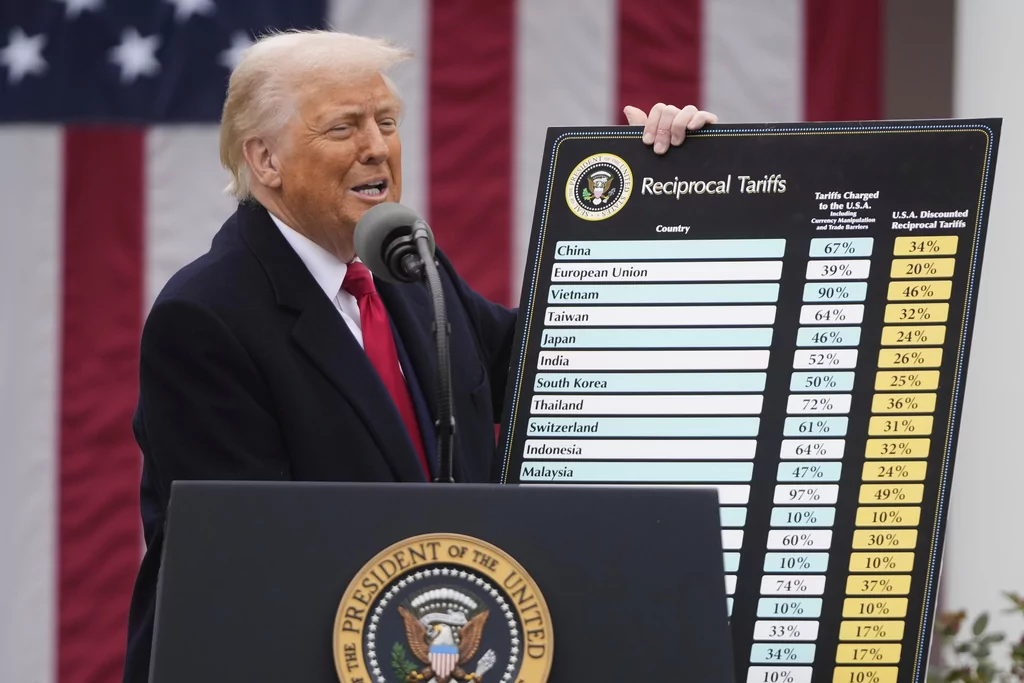President Donald Trump announced his “Liberation Day” reciprocal tariffs on Wednesday, saying countries that tax U.S. imports will be slapped with at least 10% additional tariffs on their exports to the United States.
Trump claimed it was the start of a new dawn to U.S. prosperity and the end of trade imbalances, which he said have hurt U.S. workers for too long.
WHAT ARE THE ‘DIRTY 15’ COUNTRIES THAT WILL BE MOST AFFECTED BY TRUMP’S TARIFFS?
“It’s our declaration of economic independence,” Trump said during a midafternoon event in the Rose Garden with autoworkers, Cabinet members, and members of Congress.
Trump, who held a big chart of rates, revealed that countries, regardless of whether they are staunch allies or adversaries, would be slapped with at least a 10% tariff.
Trump lobbed a 34% tariff against China, in addition to a previous 20% tariff, bringing the total to 54%. Meanwhile, Cambodia (49%), Laos (48%), and Vietnam (46%) were among the hardest hit with “discounted” reciprocal tariffs. The United Kingdom and Australia were among the countries to get hit with the minimum 10% tariff.
Some of the harshest rates were on nations that many Americans know little about.
Lesotho, a little-known nation in Southern Africa, and Saint Pierre and Miquelon, a French territory in North America, were hit with the highest reciprocal tariffs at 50% each.
Notably, Canada and Mexico were not on the list of countries the Trump administration was levying fresh tariffs against and are exempt from the baseline 10% tariffs.
Yet, the two nations are still subject to Trump’s previous 25% tariffs with exemptions for goods that fall under the United States-Mexico-Canada Agreement, which was negotiated during Trump’s first presidential term. Trump’s additional 25% tariffs on foreign automobiles are likely to have a severe impact on the two countries as well.
Senior administration officials explained to reporters on a press call that the baseline 10% rate will go into effect on April 5, at 12:01 am, and the higher reciprocal rates will go into effect on April 9, at 12:01 am.
Theoretically, the delay in the implementation could give foreign nations the chance to negotiate with Trump on the rate and tamp down tensions.
However, the administration did not appear amenable to more bargaining. “This is not a negotiation, it’s a national emergency,” a senior trump administration official said before the event.
Trump, who has long backed tariffs despite warnings from economists and fellow Republicans that they could raise prices on consumers, described the state of the world trade economy in dire terms.
“For decades, our country has been looted, pillaged, raped, and plundered by nations near and far, both friend and foe alike,” Trump said, pointing to the loss of U.S. factories and outsourcing manufacturing jobs.
“With today’s action, we are finally going to be able to make America great again – greater than ever before,” he added. “Jobs in factories will come roaring back into our country.”

Trump’s tariffs are a risky move that could roil the stock market and the global economy and lead to higher prices for the average American consumer. Economists have long warned about a possible recession if Trump were to follow through on his threat to impose tariffs on the nation’s trading partners.
Competitive Enterprise Institute senior economist Ryan Young said Trump’s new round of tariffs could spell big trouble for the economy.
“Trump redefined ‘reciprocal’ to mean ‘other forms of cheating,’ which is another way of saying he’ll do whatever he wants,” Young said. “For now, Trump will impose tariffs much higher than what most of the world charges. The global average tariff was under 5% in 2017, the year before Trump’s trade war began.”
Trump’s previous announcement of 25% tariffs on all automobiles and car parts not manufactured in the U.S. could lead to higher prices for new and used cars. While the president warned automakers not to pass on increased car prices to consumers, Trump later said he “couldn’t care less” if automakers did increase prices due to tariffs.
Amid jitters from Wall Street and economists, the Trump administration predicted big results.
“It is going to work,” said White House press secretary Karoline Leavitt during a Tuesday press briefing when asked if the Trump administration could be proven wrong. “The president has a brilliant team of advisers who have been studying these issues for decades, and we are focused on restoring the golden age of America.”
However, Republican lawmakers on Capitol Hill were not as confident as the White House.
“I think all of us are anxious to see … what the president actually comes out with in terms of tariff policy,” Senate Majority Leader John Thune (R-SD) said this week.
Democrats scoffed at the Trump administration’s insistence that tariffs could bring in billions of dollars.
“Republicans are crashing the American economy in real time and driving us to a recession. This is not Liberation Day. It’s Recession Day in the United States of America,” said House Minority Leader Hakeem Jeffries (D-NY).
Before the event, Treasury Secretary Scott Bessent and National Economic Council Director Kevin Hassett singled out the “Dirty 15” countries on which the Trump administration planned to impose severe tariffs.
Trump’s previous tariff threats against Canada and Mexico were repeatedly delayed before finally arriving on March 4, prompting retaliation from the U.S.’s neighbors. It didn’t take long before the president issued exemptions that tamed tensions between the three nations.
Trump’s general views on tariffs have been known for decades, as he has complained about what he sees as unfair trade with other countries since the 1980s. However, he is now empowered to pursue those aims like never before, leaving enemies and allies alike anxious over the last several weeks.
Australian Prime Minister Anthony Albanese said the tariffs were “unwarranted”.
“This is not the act of a friend,” he said.
The reciprocal tariff push dates back to Feb. 13, when Trump signed an executive order directing his team to study tariffs that could be imposed on more than 150 different countries.
“The idea that the United States has one of the most open economies and has among the lowest average weighted tariff rates in the world,” Trump’s memorandum says. “The United States imposes fewer barriers to imports than other major world economies, including those with similar political and economic systems.”
“Whatever countries charge the United States of America, we will charge them,” the president said during an Oval Office signing ceremony. “We’re going to make America rich again.”
Trump acolytes have said the end result of the move could be lower tariffs, pointing to news such as Israel removing its tariffs on U.S. goods ahead of April 2. On the other hand, detractors have warned that tariffs will repel allies and enemies alike, pointing to news such as China, Japan, and South Korea making a rare show of public cooperation to combat Trump’s tariffs.
‘LIBERATION DAY” MEANS 10% MINIMUM TARIFFS ON AMERICAN IMPORTS WITH ZERO EXCEPTIONS
Conventional economic wisdom has long held that tariffs are a drag on the economy and a tax on consumers. Yet, the Trump White House is pushing forward aggressively with arguments that his tariffs will rebuild U.S. manufacturing, create jobs, and improve military readiness.
“More production at home will mean stronger competition and lower prices for consumers,” Trump said. “This will be, indeed, the golden age of America. It’s coming back.”
Ramsey Touchberry and David Sivak contributed to this report.
























